Geographic Disparity in Machine Intelligence Approaches for Archaeological Remote Sensing Research
Abstract
1. Introduction
2. A Brief Overview of Machine Intelligence Research in Archaeological Remote Sensing
3. Geographic Disparities within Archaeological Machine Intelligence
| TS = ((automat* AND image analysis AND archaeol*) OR (semi-automat* detection AND archaeol*) OR (machine learning AND archaeol*) OR (deep learning AND archaeol*) OR (artificial intelligence AND archaeol*) OR (supervised classification AND archaeol*) OR (unsupervised classification AND archaeol*) OR (object based image analysis AND archaeol*) OR (neural network AND archaeol*)) |
4. Potential Solutions to the Global Divide in Machine Intelligence Research
Example of Solutions in Action
5. Conclusions
Author Contributions
Funding
Acknowledgments
Conflicts of Interest
References
- Snow, D.R. Enhanced: Cybertools and archaeology. Science 2006, 311, 958–959. [Google Scholar] [CrossRef]
- Data, Now Bigger and Better; Boellstorff, T., Maurer, B., Eds.; Prickly Paradigm Press: Chicago, IL, USA, 2015. [Google Scholar]
- Proietti, M.; Pickston, A.; Graffitti, F.; Barrow, P.; Kundys, D.; Branciard, C.; Ringbauer, M.; Fedrizzi, A. Experimental test of local observer independence. Sci. Adv. 2019, 5, eaaw9832. [Google Scholar] [CrossRef]
- Orengo, H.A.; Garcia-Molsosa, A. A brave new world for archaeological survey: Automated machine learning-based potsherd detection using high-resolution drone imagery. J. Archaeol. Sci. 2019, 112, 105013. [Google Scholar] [CrossRef]
- Verschoof-van der Vaart, W.B.; Lambers, K. Learning to look at LiDAR: The use of R-CNN in the automated detection of archaeological objects in lidar data from the Netherlands. J. Comput. Appl. Archaeol. 2019, 2, 31–40. [Google Scholar] [CrossRef]
- Davis, D.S. Object-based image analysis: A review of developments and future directions of automated feature detection in landscape archaeology. Archaeol. Prospect. 2019, 26, 155–163. [Google Scholar] [CrossRef]
- Cerrillo-Cuenca, E.; Bueno-Ramírez, P. Counting with the invisible record? The role of LiDAR in the interpretation of megalithic landscapes in south-western Iberia (Extremadura, Alentejo and Beira Baixa). Archaeol. Prospect. 2019, 1–14. [Google Scholar] [CrossRef]
- Freeland, T.; Heung, B.; Burley, D.V.; Clark, G.; Knudby, A. Automated feature extraction for prospection and analysis of monumental earthworks from aerial LiDAR in the Kingdom of Tonga. J. Archaeol. Sci. 2016, 69, 64–74. [Google Scholar] [CrossRef]
- Cooper, A.; Green, C. Embracing the complexities of ‘big data’ in archaeology: The case of the english landscape and identities project. J. Archaeol. Method Theory 2016, 23, 271–304. [Google Scholar] [CrossRef]
- Bennett, R.; Cowley, D.; De Laet, V. The data explosion: Tackling the taboo of automatic feature recognition in airborne survey data. Antiquity 2014, 88, 896–905. [Google Scholar] [CrossRef]
- Lambers, K. Airborne and spaceborne remote sensing and digital image analysis in archaeology. In Digital Geoarchaeology; Siart, C., Forbriger, M., Bubenzer, O., Eds.; Springer: Cham, Switzerland, 2018; pp. 109–122. ISBN 978-3-319-25314-5. [Google Scholar]
- Traviglia, A.; Torsello, A. Landscape pattern detection in archaeological remote sensing. Geosciences 2017, 7, 128. [Google Scholar] [CrossRef]
- Arvor, D.; Belgiu, M.; Falomir, Z.; Mougenot, I.; Durieux, L. Ontologies to interpret remote sensing images: Why do we need them? GISci. Remote Sens. 2019, 1–29. [Google Scholar] [CrossRef]
- Davis, D.S.; Lipo, C.P.; Sanger, M.C. A comparison of automated object extraction methods for mound and shell-ring identification in coastal South Carolina. J. Archaeol. Sci. Rep. 2019, 23, 166–177. [Google Scholar] [CrossRef]
- Cerrillo-Cuenca, E. An approach to the automatic surveying of prehistoric barrows through LiDAR. Quat. Int. 2017, 435, 135–145. [Google Scholar] [CrossRef]
- Lambers, K.; Verschoof-van der Vaart, W.; Bourgeois, Q. Integrating remote sensing, machine learning, and citizen science in dutch archaeological prospection. Remote Sens. 2019, 11, 794. [Google Scholar] [CrossRef]
- Lasaponara, R.; Masini, N. Image enhancement, feature extraction and geospatial analysis in an archaeological perspective. In Satellite Remote Sensing; Lasaponara, R., Masini, N., Eds.; Springer: Dordrecht, The Netherlands, 2012; Volume 16, pp. 17–63. ISBN 978-90-481-8800-0. [Google Scholar]
- Lasaponara, R.; Leucci, G.; Masini, N.; Persico, R. Investigating archaeological looting using satellite images and GEORADAR: The experience in Lambayeque in North Peru. J. Archaeol. Sci. 2014, 42, 216–230. [Google Scholar] [CrossRef]
- Trier, Ø.D.; Pilø, L.H. Automatic detection of pit structures in airborne laser scanning data: Automatic detection of pits in ALS data. Archaeol. Prospect. 2012, 19, 103–121. [Google Scholar] [CrossRef]
- Sanger, M.C. Determining depositional events within shell deposits using computer vision and photogrammetry. J. Archaeol. Sci. 2015, 53, 482–491. [Google Scholar] [CrossRef]
- Guyot, A.; Hubert-Moy, L.; Lorho, T. Detecting neolithic burial mounds from LiDAR-derived elevation data using a multi-scale approach and machine learning techniques. Remote Sens. 2018, 10, 225. [Google Scholar] [CrossRef]
- Aprile, A.; Castellano, G.; Eramo, G. Combining image analysis and modular neural networks for classification of mineral inclusions and pores in archaeological potsherds. J. Archaeol. Sci. 2014, 50, 262–272. [Google Scholar] [CrossRef]
- Hofmann, P.; Marschallinger, R.; Unterwurzacher, M.; Zobl, F. Marble provenance designation with object based image analysis: State-of-the-art rock fabric characterization from petrographic micrographs. Austrian J. Earth Sci. 2013, 106, 40–49. [Google Scholar]
- Magnini, L.; Bettineschi, C. Theory and practice for an object-based approach in archaeological remote sensing. J. Archaeol. Sci. 2019, 107, 10–22. [Google Scholar] [CrossRef]
- Luo, L.; Wang, X.; Guo, H.; Lasaponara, R.; Zong, X.; Masini, N.; Wang, G.; Shi, P.; Khatteli, H.; Chen, F.; et al. Airborne and spaceborne remote sensing for archaeological and cultural heritage applications: A review of the century (1907–2017). Remote Sens. Environ. 2019, 232, 111280. [Google Scholar] [CrossRef]
- Trier, Ø.D.; Cowley, D.C.; Waldeland, A.U. Using deep neural networks on airborne laser scanning data: Results from a case study of semi-automatic mapping of archaeological topography on Arran, Scotland. Archaeol. Prospect. 2019, 26, 165–175. [Google Scholar] [CrossRef]
- Pregesbauer, M.; Trinks, I.; Neubauer, W. An object oriented approach to automatic classification of archaeological features in magnetic prospection data. Surf. Geophys. 2014, 12, 651–656. [Google Scholar] [CrossRef]
- Hein, I.; Rojas-Domínguez, A.; Ornelas, M.; D’Ercole, G.; Peloschek, L. Automated classification of archaeological ceramic materials by means of texture measures. J. Archaeol. Sci. Rep. 2018, 21, 921–928. [Google Scholar] [CrossRef]
- Ozawa, K. Classification of the keyhole shaped tombs by template matching method. IEEE Trans. Comput. 1978, 27, 462–467. [Google Scholar] [CrossRef]
- Parcak, S. Archaeology from Space: How the Future Shapes Our Past; Henry Holt and Co.: New York, NY, USA, 2019. [Google Scholar]
- Davis, D.S.; Sanger, M.C.; Lipo, C.P. Automated mound detection using lidar and object-based image analysis in Beaufort County, South Carolina. Southeast Archaeol. 2019, 38, 23–37. [Google Scholar] [CrossRef]
- Nyerges, A.E.; Green, G.M. The ethnography of landscape: GIS and remote sensing in the study of forest change in west African Guinea Savanna. Am. Anthropol. 2000, 102, 271–289. [Google Scholar] [CrossRef]
- Canuto, M.A.; Estrada-Belli, F.; Garrison, T.G.; Houston, S.D.; Acuña, M.J.; Kováč, M.; Marken, D.; Nondédéo, P.; Auld-Thomas, L.; Castanet, C.; et al. Ancient lowland Maya complexity as revealed by airborne laser scanning of northern Guatemala. Science 2018, 361, eaau0137. [Google Scholar] [CrossRef]
- Menze, B.H.; Ur, J.A. Mapping patterns of long-term settlement in Northern Mesopotamia at a large scale. Proc. Natl. Acad. Sci. USA 2012, 109, E778–E787. [Google Scholar] [CrossRef]
- Bintliff, J.; Howard, P.; Snodgrass, A. The hidden landscape of prehistoric Greece. J. Mediterr. Archaeol. 1999, 12, 139–168. [Google Scholar] [CrossRef]
- Feiken, H. Dealing with Biases: Three Geo-Archaeological Approaches to the Hidden Landscapes of Italy; Barkhuis: Eelde, The Netherlands, 2014; ISBN 978-94-92444-38-7. [Google Scholar]
- Stafford, C.R.; Creasman, S.D. The hidden record: Late Holocene landscapes and settlement archaeology in the Lower Ohio River Valley. Geoarchaeology 2002, 17, 117–140. [Google Scholar] [CrossRef]
- Stephens, L.; Fuller, D.; Boivin, N.; Rick, T.; Gauthier, N.; Kay, A.; Marwick, B.; Armstrong, C.G.; Barton, C.M.; Denham, T.; et al. Archaeological assessment reveals Earth’s early transformation through land use. Science 2019, 365, 897–902. [Google Scholar] [CrossRef] [PubMed]
- S/RES/2347 (2017)|United Nations Security Council. Available online: https://www.un.org/securitycouncil/s/res/2347-%282017%29 (accessed on 6 January 2020).
- Lasaponara, R.; Masini, N. Space-based identification of archaeological illegal excavations and a new automatic method for looting feature extraction in desert areas. Surv. Geophys. 2018, 39, 1323–1346. [Google Scholar] [CrossRef]
- Lauricella, A.; Cannon, J.; Branting, S.; Hammer, E. Semi-automated detection of looting in Afghanistan using multispectral imagery and principal component analysis. Antiquity 2017, 91, 1344–1355. [Google Scholar] [CrossRef]
- Tapete, D.; Cigna, F. Detection of archaeological looting from space: Methods, achievements and challenges. Remote Sens. 2019, 11, 2389. [Google Scholar] [CrossRef]
- Davis, D.S.; Douglass, K. Aerial and spaceborne remote sensing in African archaeology: A review of current research and potential future avenues. Afr. Archaeol. Rev. 2020, 37. in press. [Google Scholar] [CrossRef]
- Lock, G. Using Computers in Archaeology: Towards Virtual Pasts; Routledge: New York, NY, USA, 2003. [Google Scholar]
- Richards, J.D.; Ryan, N.S. Data Processing in Archaeology; Cambridge Manuals in Archaeology; Cambridge University Press: Cambridge, UK, 1985. [Google Scholar]
- Binford, L.R.; Binford, S.R. A preliminary analysis of functional variability in the mousterian of leuallois facies. Am. Anthropol. 1966, 68, 238–295. [Google Scholar] [CrossRef]
- Carneiro, R.L. A quantitative law in anthropology. Am. Antiq. 1970, 35, 492–494. [Google Scholar] [CrossRef]
- Tugby, D.J. Archaeological objectives and statistical methods: A frontier in archaeology. Am. Antiq. 1965, 31, 1–16. [Google Scholar] [CrossRef]
- Verhoeven, G.; Sevara, C. Trying to break new ground in aerial archaeology. Remote Sens. 2016, 8, 918. [Google Scholar] [CrossRef]
- McCoy, M.D.; Ladefoged, T.N. New developments in the use of spatial technology in archaeology. J. Archaeol. Res. 2009, 17, 263–295. [Google Scholar] [CrossRef]
- Chase, A.F.; Chase, D.Z.; Fisher, C.T.; Leisz, S.J.; Weishampel, J.F. Geospatial revolution and remote sensing LiDAR in Mesoamerican archaeology. Proc. Natl. Acad. Sci. USA 2012, 109, 12916–12921. [Google Scholar] [CrossRef]
- Custer, J.F.; Eveleigh, T.; Klemas, V.; Wells, I. Application of landsat data and synoptic remote sensing to predictive models for prehistoric archaeological sites: An example from the Delaware Coastal Plain. Am. Antiq. 1986, 51, 572–588. [Google Scholar] [CrossRef]
- Kirk, S.D.; Thompson, A.E.; Lippitt, C.D. Predictive modeling for site detection using remotely sensed phenological data. Adv. Archaeol. Pract. 2016, 4, 87–101. [Google Scholar] [CrossRef]
- Mann, J.; Xutong, N. Statistical Development to Predict Archaeological Site Locations—A Pilot Study; National Resources Conservation Service (NRCS): Troy, AL, USA, 2011. [Google Scholar]
- Davis, D.S.; Andriankaja, V.; Carnat, T.L.; Chrisostome, Z.M.; Colombe, C.; Fenomanana, F.; Hubertine, L.; Justome, R.; Lahiniriko, F.; Léonce, H.; et al. Satellite-based remote sensing rapidly reveals extensive record of Holocene coastal settlement on Madagascar. J. Archaeol. Sci. 2020, 115, 105097. [Google Scholar] [CrossRef]
- Meredith-Williams, M.G.; Hausmann, N.; Bailey, G.N.; King, G.C.P.; Alsharekh, A.; Al Ghamdi, S.; Inglis, R.H. Mapping, modelling and predicting prehistoric coastal archaeology in the southern Red Sea using new applications of digital-imaging techniques. World Archaeol. 2014, 46, 10–24. [Google Scholar] [CrossRef]
- Verhagen, P.; Whitley, T.G. Integrating archaeological theory and predictive modeling: A live report from the scene. J. Archaeol. Method Theory 2012, 19, 49–100. [Google Scholar] [CrossRef]
- Blaschke, T. Object based image analysis for remote sensing. ISPRS J. Photogramm. Remote Sens. 2010, 65, 2–16. [Google Scholar] [CrossRef]
- Hay, G.J.; Castilla, G. Geographic Object-Based Image Analysis (GEOBIA): A new name for a new discipline. In Object-Based Image Analysis; Blaschke, T., Lang, S., Hay, G., Eds.; Springer: Heidelberg/Berlin, Germany, 2008; pp. 75–89. [Google Scholar]
- Chen, G.; Weng, Q.; Hay, G.J.; He, Y. Geographic object-based image analysis (GEOBIA): Emerging trends and future opportunities. GISci. Remote Sens. 2018, 55, 159–182. [Google Scholar] [CrossRef]
- Sevara, C.; Pregesbauer, M.; Doneus, M.; Verhoeven, G.; Trinks, I. Pixel versus object—A comparison of strategies for the semi-automated mapping of archaeological features using airborne laser scanning data. J. Archaeol. Sci. Rep. 2016, 5, 485–498. [Google Scholar] [CrossRef]
- Wang, S.; Hu, Q.; Wang, F.; Ai, M.; Zhong, R. A microtopographic feature analysis-based LiDAR data processing approach for the identification of Chu Tombs. Remote Sens. 2017, 9, 880. [Google Scholar] [CrossRef]
- Fu, T.; Ma, L.; Li, M.; Johnson, B.A. Using convolutional neural network to identify irregular segmentation objects from very high-resolution remote sensing imagery. J. Appl. Remote Sens. 2018, 12, 1. [Google Scholar] [CrossRef]
- Caspari, G.; Crespo, P. Convolutional neural networks for archaeological site detection—Finding “princely” tombs. J. Archaeol. Sci. 2019, 110, 104998. [Google Scholar] [CrossRef]
- Casana, J. Regional-scale archaeological remote sensing in the age of big data. Adv. Archaeol. Pract. 2014, 2, 222–233. [Google Scholar] [CrossRef]
- Hanson, W.S. The future of aerial archaeology in Europe. Photo Interprétation Eur. J. Appl. Remote Sens. 2010, 46, 3–11. [Google Scholar]
- Parcak, S.H. Satellite Remote Sensing for Archaeology; Routledge: New York, NY, USA, 2009. [Google Scholar]
- Lamotte, A.; Masson, É. Arché-OBIA: Un concept d’analyse quantitative d’images numériques appliqué aux bifaces du gisement de Gouzeaucourt (Nord, FR). Notae Praehist. 2016, 36, 121–130. [Google Scholar]
- Borie, C.; Parcero-Oubiña, C.; Kwon, Y.; Salazar, D.; Flores, C.; Olguín, L.; Andrade, P. Beyond site detection: The role of satellite remote sensing in analysing archaeological problems. A case study in Lithic Resource Procurement in the Atacama Desert, Northern Chile. Remote Sens. 2019, 11, 869. [Google Scholar] [CrossRef]
- Opitz, R.; Herrmann, J. Recent trends and long-standing problems in archaeological remote sensing. J. Comput. Appl. Archaeol. 2018, 1, 19–41. [Google Scholar] [CrossRef]
- Monna, F.; Magail, J.; Rolland, T.; Navarro, N.; Wilczek, J.; Gantulga, J.-O.; Esin, Y.; Granjon, L.; Allard, A.-C.; Chateau-Smith, C. Machine learning for rapid mapping of archaeological structures made of dry stones–Example of burial monuments from the Khirgisuur culture, Mongolia–. J. Cult. Herit. 2020. [Google Scholar] [CrossRef]
- Beaudry, C.; Mouton, J. The Next Generation of Scientists in Africa; African Minds: Cape Town, South Africa, 2018. [Google Scholar]
- Thabeng, O.L.; Merlo, S.; Adam, E. High-resolution remote sensing and advanced classification techniques for the prospection of archaeological sites’ markers: The case of dung deposits in the Shashi-Limpopo Confluence area (southern Africa). J. Archaeol. Sci. 2019, 102, 48–60. [Google Scholar] [CrossRef]
- Klehm, C.; Barnes, A.; Follett, F.; Simon, K.; Kiahtipes, C.; Mothulatshipi, S. Toward archaeological predictive modeling in the Bosutswe region of Botswana: Utilizing multispectral satellite imagery to conceptualize ancient landscapes. J. Anthropol. Archaeol. 2019, 54, 68–83. [Google Scholar] [CrossRef]
- Pedró, F.; Subosa, M.; Rivas, A.; Valverde, P. Artificial Intelligence in Education: Challenges and Opportunities for Sustainable Development; UNESCO: Paris, France, 2019. [Google Scholar]
- Kansa, E.C.; Kansa, S.W.; Wells, J.J.; Yerka, S.J.; Myers, K.N.; DeMuth, R.C.; Bissett, T.G.; Anderson, D.G. The digital index of north american archaeology: Networking government data to navigate an uncertain future for the past. Antiquity 2018, 92, 490–506. [Google Scholar] [CrossRef]
- Kansa, E.C.; Kansa, S.W. Toward a do-it-yourself cyberinfrastructure: Open data, incentives, and reducing costs and complexities of data sharing. In Archaeology 2.0: New Approaches to Communication and Collaboration Location; Kansa, E.C., Kansa, S.W., Watrall, E., Eds.; Cotsen Digital Archaeology Series; Cotsen Institute of Archaeology: Los Angeles, CA, USA, 2011. [Google Scholar]
- Marwick, B. Computational reproducibility in archaeological research: Basic principles and a case study of their implementation. J. Archaeol. Method Theory 2017, 24, 424–450. [Google Scholar] [CrossRef]
- Quintus, S.; Day, S.S.; Smith, N.J. The efficacy and analytical importance of manual feature extraction using lidar datasets. Adv. Archaeol. Pract. 2017, 5, 351–364. [Google Scholar] [CrossRef]
- Hegyi, A.; Vernica, M.-M.; Drăguţ, L. An object-based approach to support the automatic delineation of magnetic anomalies. Archaeol. Prospect. 2019. [Google Scholar] [CrossRef]
- Katz, J.S. Geographical proximity and scientific collaboration. Scientometrics 1994, 31, 31–43. [Google Scholar] [CrossRef]
- Glänzel, W.; Schubert, A. Analysing scientific networks through co-authorship. In Handbook of Quantitative Science and Technology Research; Springer: Berlin, Germany, 2004; pp. 257–276. [Google Scholar]
- Cerra, D.; Plank, S.; Lysandrou, V.; Tian, J. Cultural heritage sites in danger—Towards automatic damage detection from space. Remote Sens. 2016, 8, 781. [Google Scholar] [CrossRef]
- Luo, L.; Wang, X.; Guo, H.; Liu, C.; Liu, J.; Li, L.; Du, X.; Qian, G. Automated extraction of the archaeological tops of qanat shafts from vhr imagery in Google Earth. Remote Sens. 2014, 6, 11956–11976. [Google Scholar] [CrossRef]
- Soroush, M.; Mehrtash, A.; Khazraee, E.; Ur, J.A. Deep learning in archaeological remote sensing: Automated qanat detection in the kurdistan region of Iraq. Remote Sens. 2020, 12, 500. [Google Scholar] [CrossRef]
- Holon, I.Q. Artificial Intelligence & Global Education; Holon IQ: San Francisco, CA, USA, 2019. [Google Scholar]
- Gaines, S.W.; Most, R. Computerized data sharing: The SARG example of cooperative research. In Computer Applications in Archaeology; Laflin, S., Ed.; Center for Computing and Computer Science, University of Birmingham: Birmingham, UK, 1982; pp. 19–32. [Google Scholar]
- Chenhall, R.G. The archaeological data bank: A progress report. Comput. Humanit. 1971, 5, 159–169. [Google Scholar] [CrossRef]
- Colwell, C. Collaborative archaeologies and descendant communities. Annu. Rev. Anthropol. 2016, 45, 113–127. [Google Scholar] [CrossRef]
- Douglass, K.; Morales, E.Q.; Manahira, G.; Fenomanana, F.; Samba, R.; Lahiniriko, F.; Chrisostome, Z.M.; Vavisoa, V.; Soafiavy, P.; Justome, R.; et al. Toward a just and inclusive environmental archaeology of southwest Madagascar. J. Soc. Archaeol. 2019. [Google Scholar] [CrossRef]
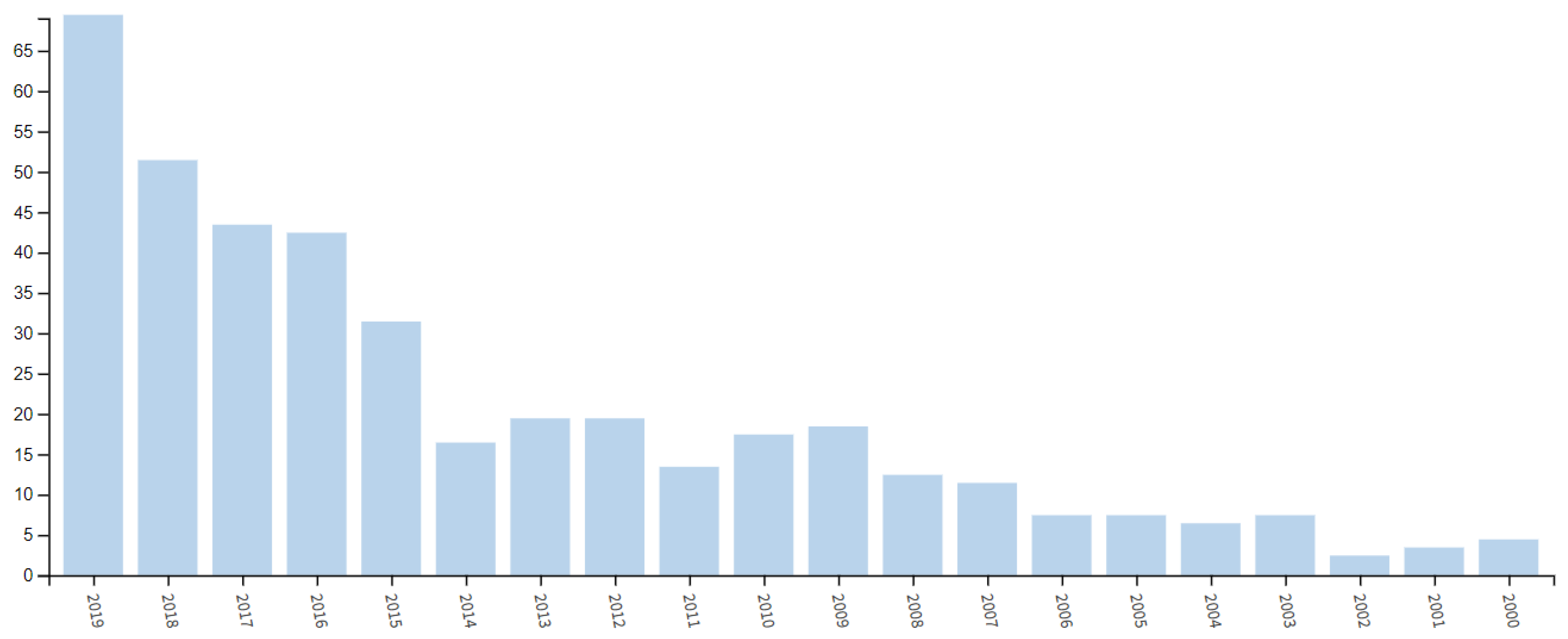
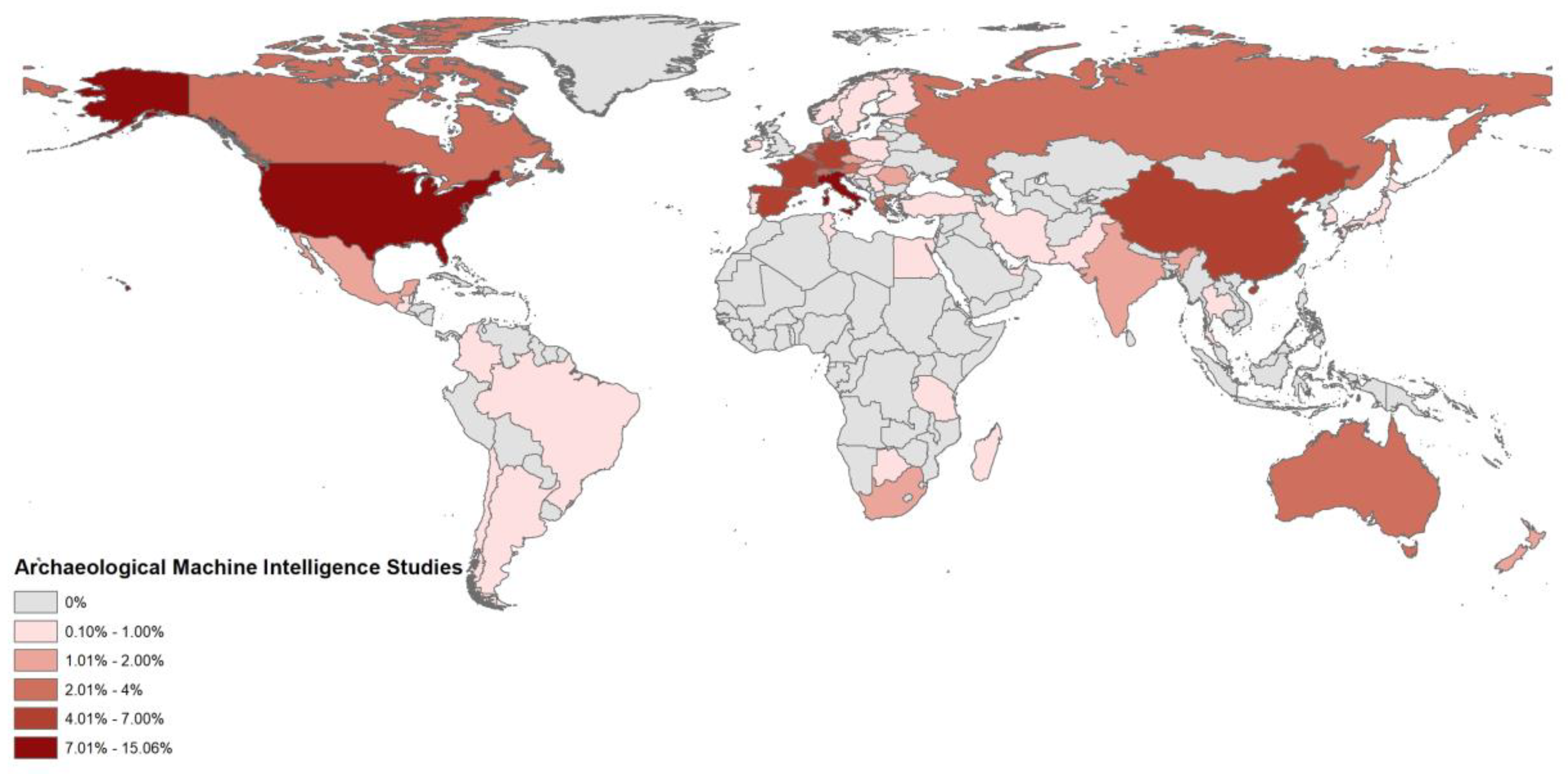
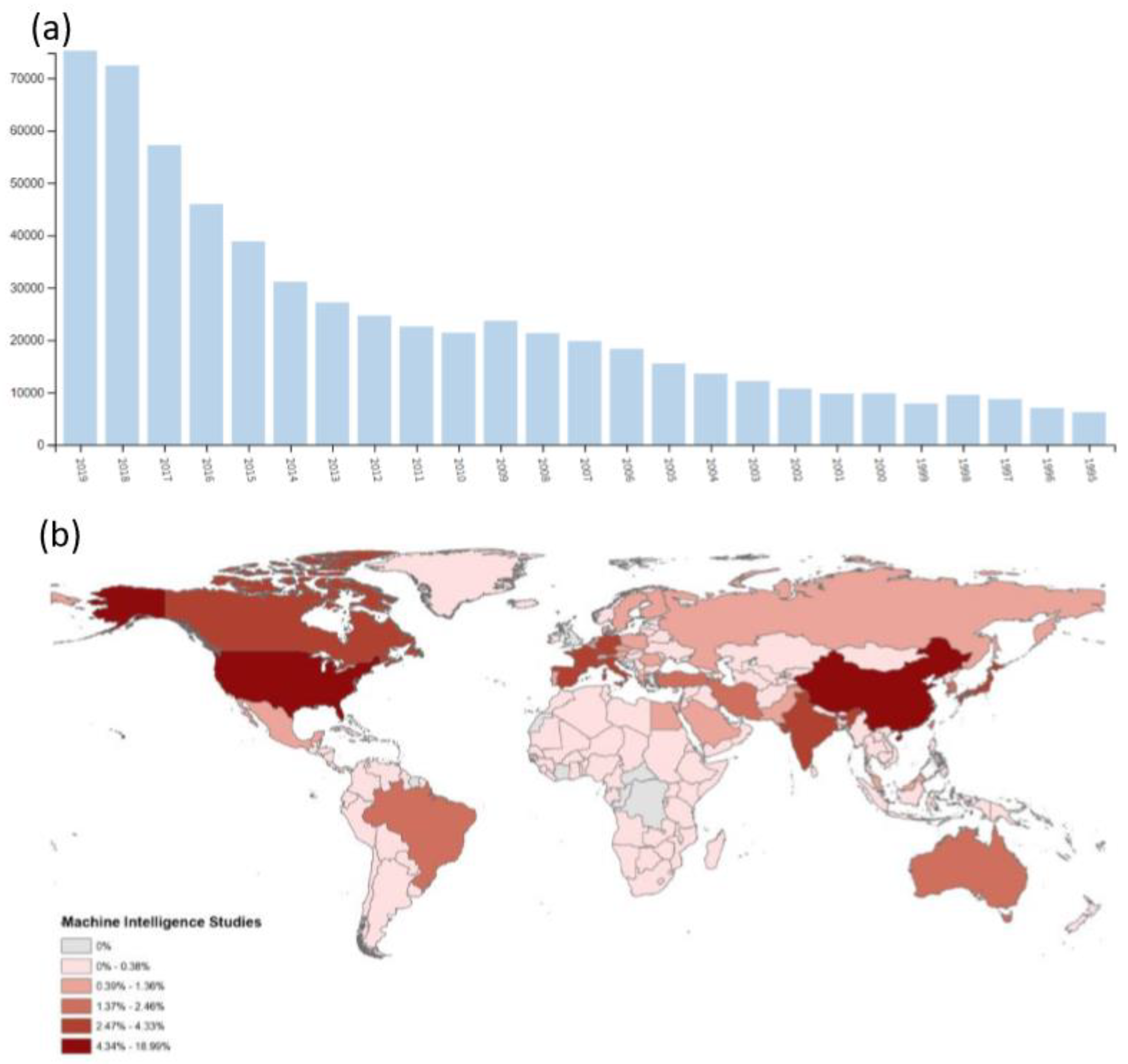
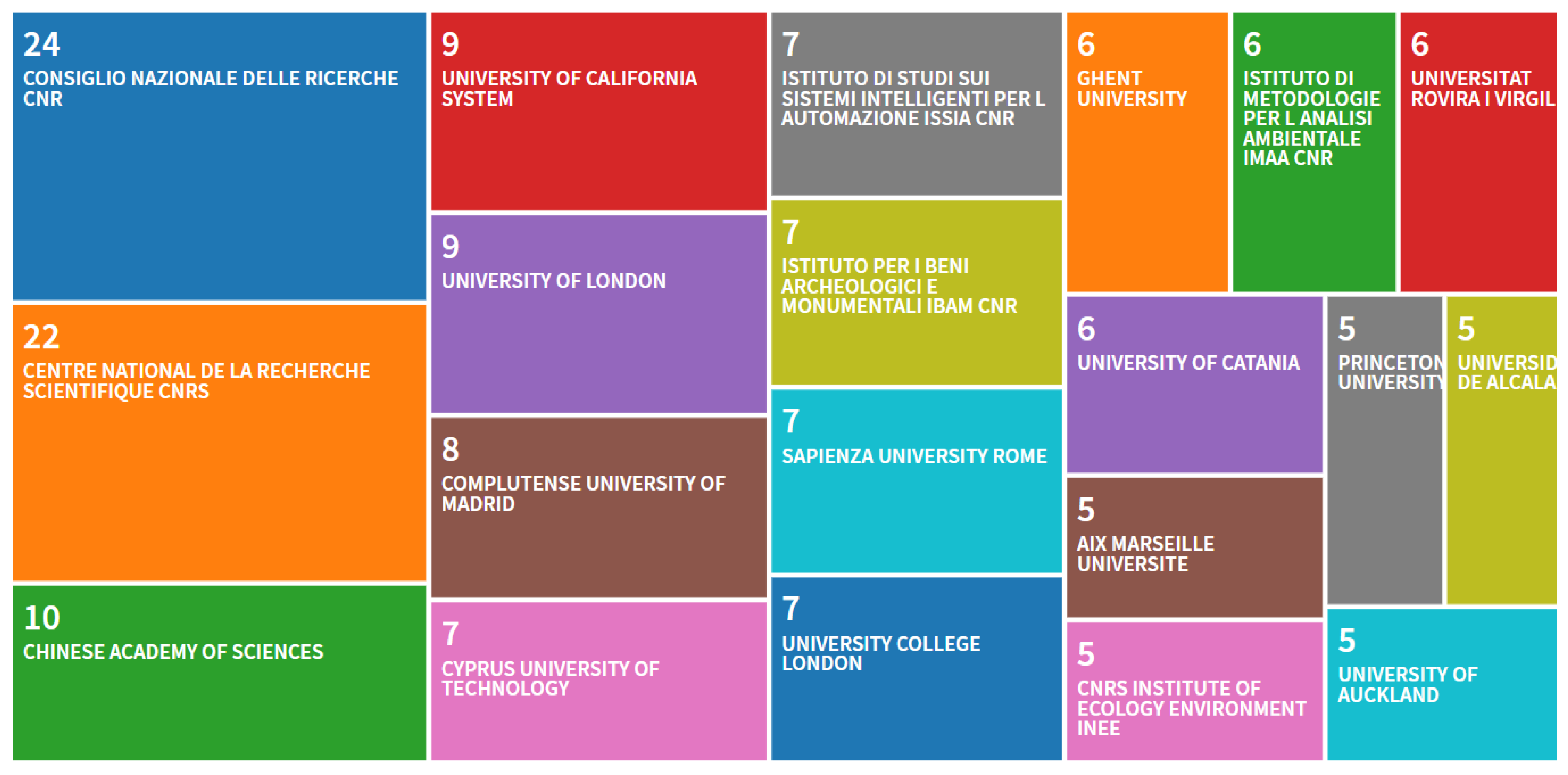
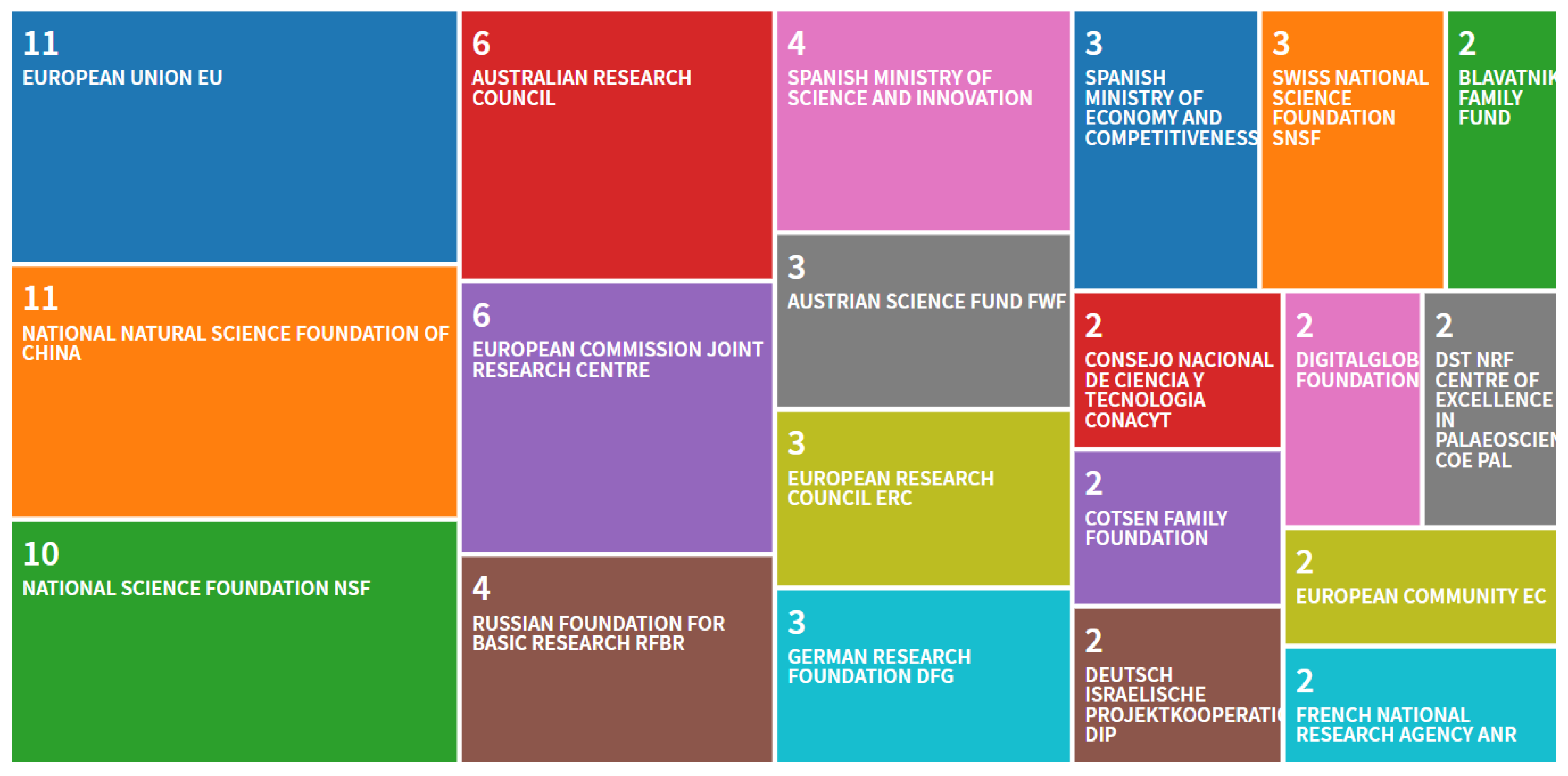
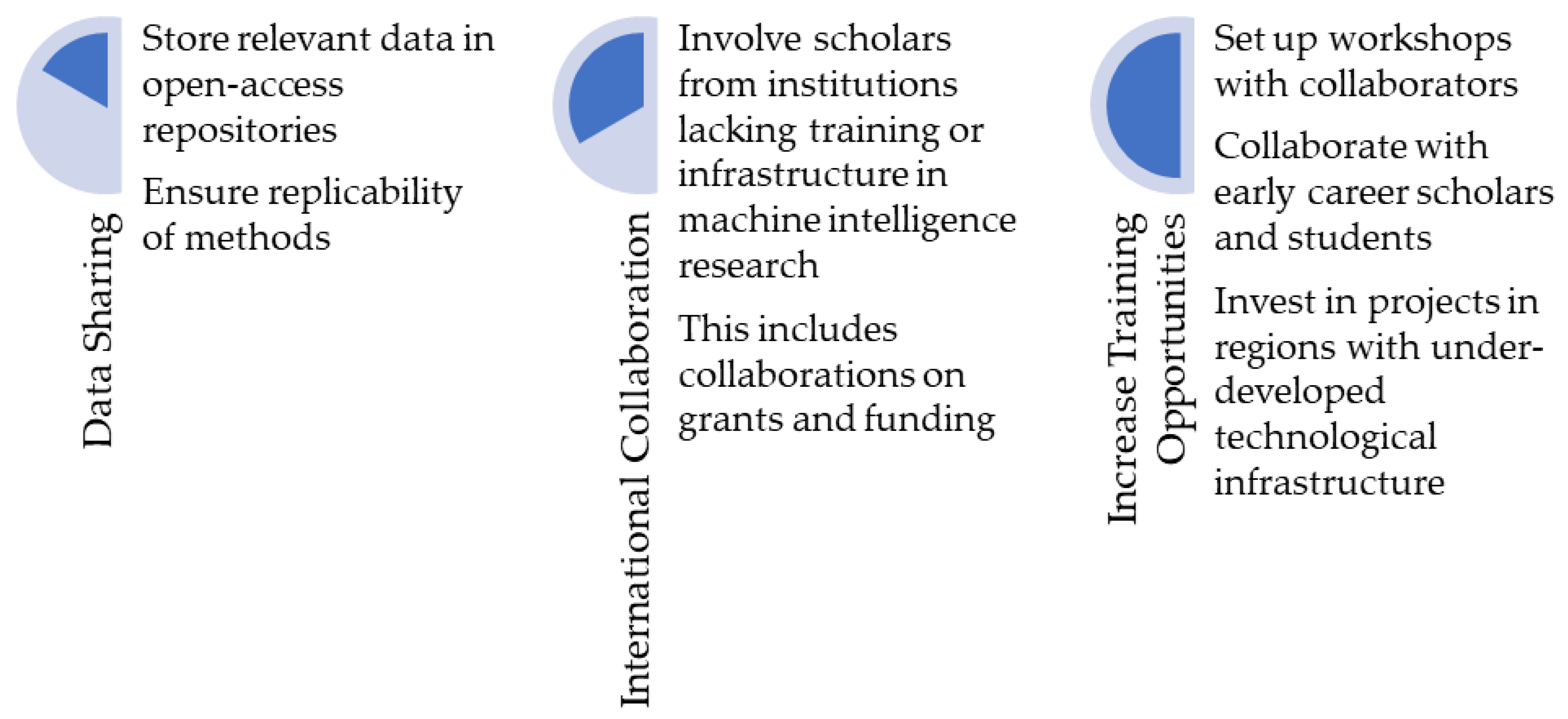
| Search Terms | Number of Results | Top Institutions Affiliated with Publications |
|---|---|---|
| Machine learning AND archaeology | 102 | Northwestern University (USA) Harvard University (USA) University of Washington (USA) |
| Artificial intelligence AND archaeology | 545 | Vienna University of Technology (Austria) Ghent University (Belgium) University of Vienna (Austria) |
| Archaeology AND automation | 37 | HafenCity University Hamburg (Germany) Polytechnic University of Milan (Italy) Vienna University of Technology (Austria) |
| Deep-learning AND archaeology | 7 | Washington University (USA) University of Ontario (Canada) Norweigen Computing Center (Norway) |
| artificial neural network AND archaeology | 29 | Centre National de la Recherche Scientifique (France) Mongolian Academy of Sciences (Mongolia) University of Burgundy (France) |
| Statistical Classification AND Archaeology | 7 | Spanish National Research Council (Spain) Marche Polytechnic University (Italy) Nanjing University of Information Science and Technology (China) |
© 2020 by the author. Licensee MDPI, Basel, Switzerland. This article is an open access article distributed under the terms and conditions of the Creative Commons Attribution (CC BY) license (http://creativecommons.org/licenses/by/4.0/).
Share and Cite
Davis, D.S. Geographic Disparity in Machine Intelligence Approaches for Archaeological Remote Sensing Research. Remote Sens. 2020, 12, 921. https://doi.org/10.3390/rs12060921
Davis DS. Geographic Disparity in Machine Intelligence Approaches for Archaeological Remote Sensing Research. Remote Sensing. 2020; 12(6):921. https://doi.org/10.3390/rs12060921
Chicago/Turabian StyleDavis, Dylan S. 2020. "Geographic Disparity in Machine Intelligence Approaches for Archaeological Remote Sensing Research" Remote Sensing 12, no. 6: 921. https://doi.org/10.3390/rs12060921
APA StyleDavis, D. S. (2020). Geographic Disparity in Machine Intelligence Approaches for Archaeological Remote Sensing Research. Remote Sensing, 12(6), 921. https://doi.org/10.3390/rs12060921






